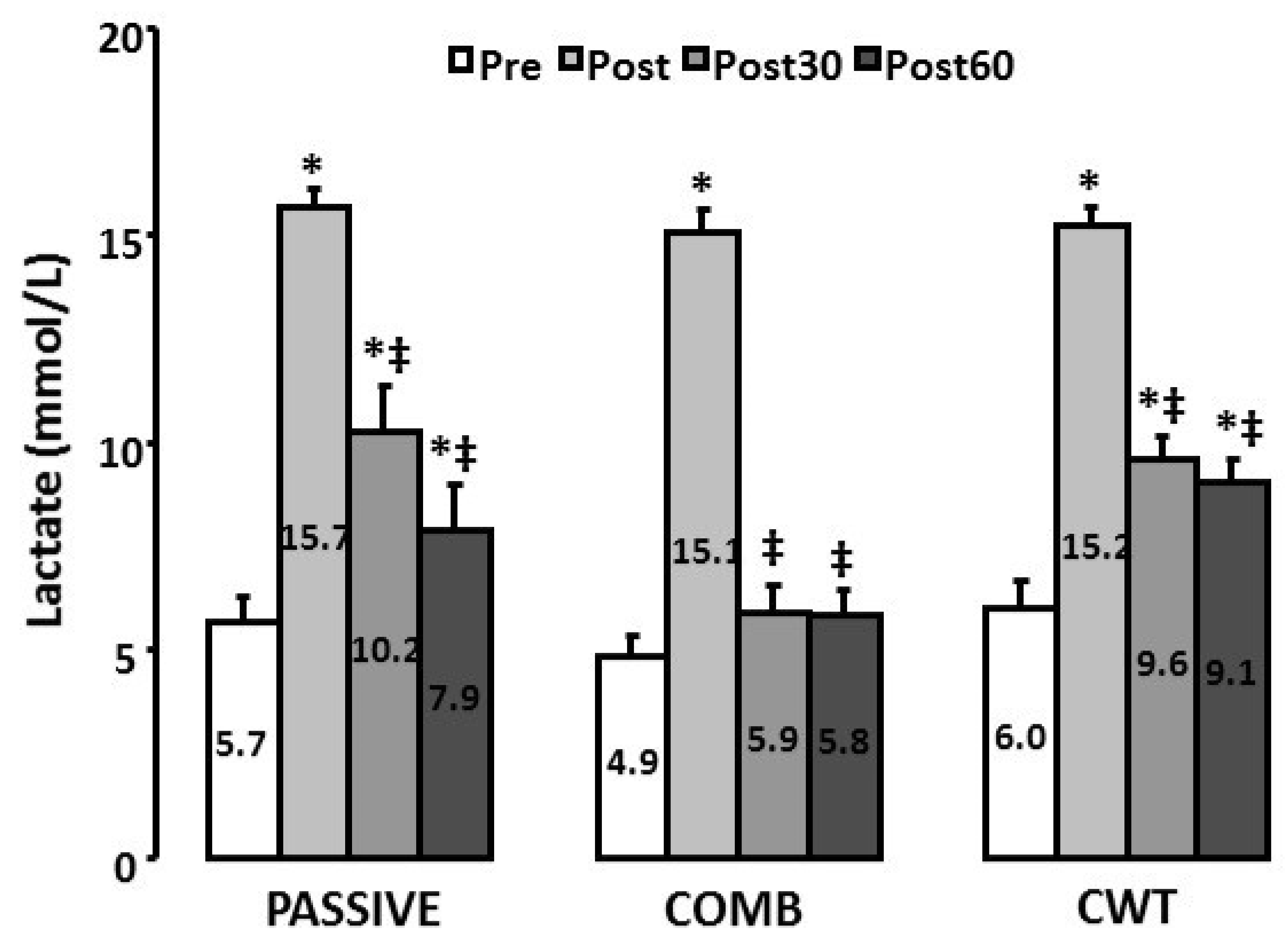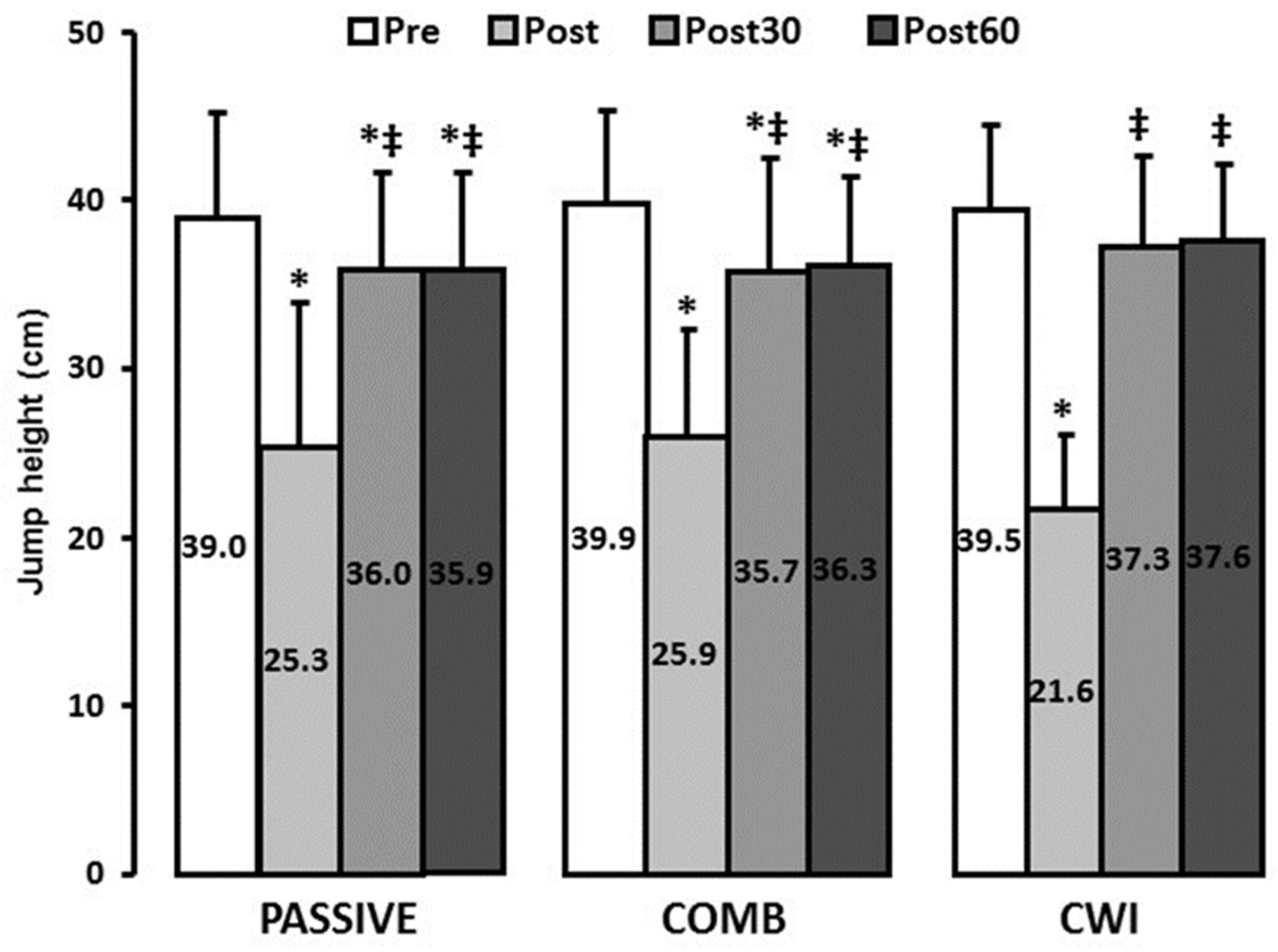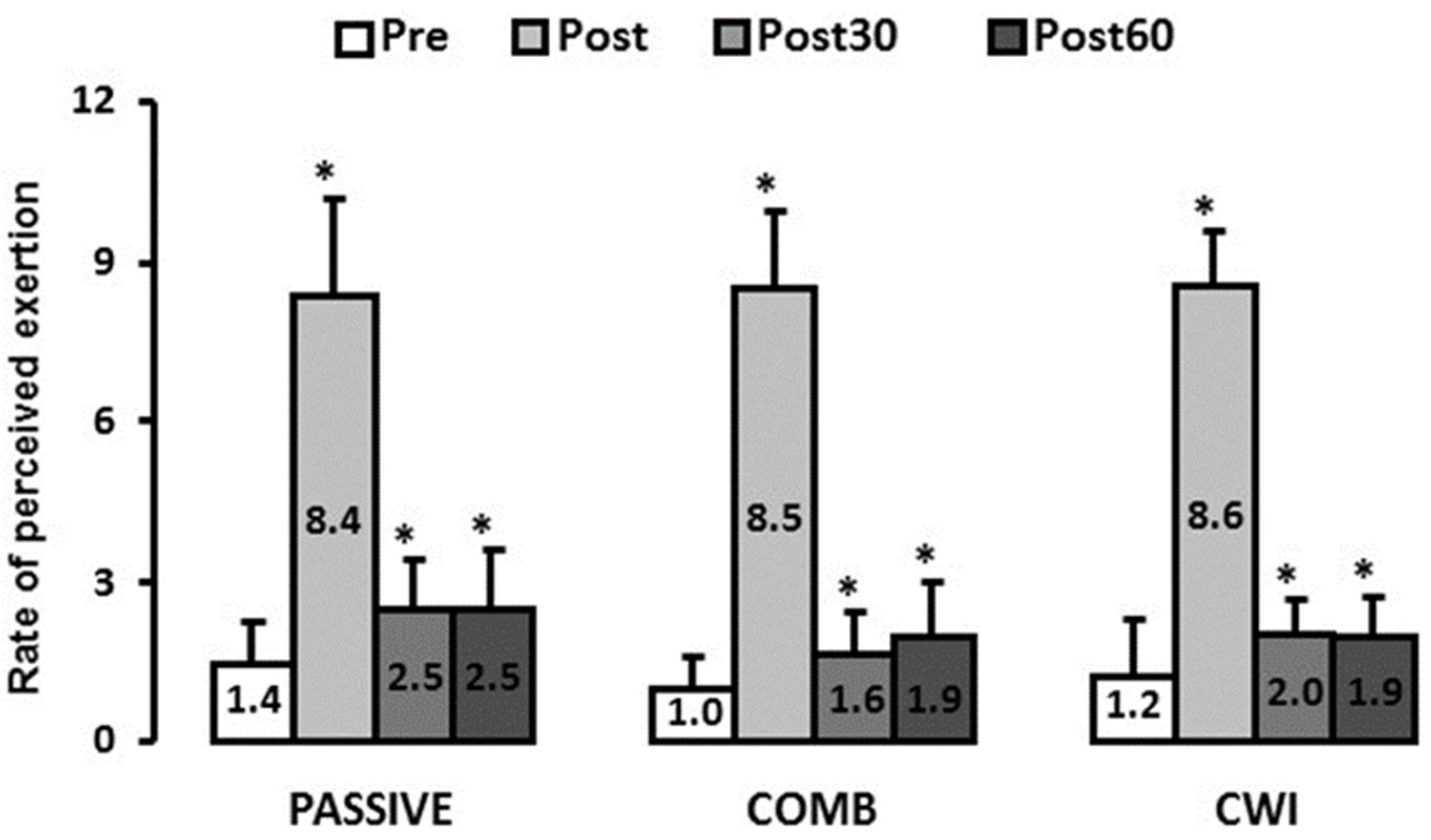Effects of Light Pedaling Added to Contrast Water Immersion for Recovery after Exhaustive Exercise
Abstract
:1. Introduction
2. Materials and Methods
2.1. Experimental Design
2.2. Exhaustive Intermittent Exercise
2.3. Measurements
2.4. Recovery Interventions
2.5. Statistical Analyses
3. Results
3.1. Effects of High-Intensity Intermittent Exercise
3.2. Lactate
3.3. Countermovement Jump
3.4. Perceived Exertion
4. Discussion
Practical Applications
5. Conclusions
Author Contributions
Funding
Institutional Review Board Statement
Informed Consent Statement
Data Availability Statement
Conflicts of Interest
References
- Reilly, T.; Ekblom, B. The use of recovery methods post exercise. J. Sports Sci. 2005, 23, 619–627. [Google Scholar] [CrossRef]
- Gill, N.; Beaven, C.; Cook, C. Effectiveness of post-match recovery strategies in rugby players. Br. J. Sports Med. 2006, 40, 260–263. [Google Scholar] [CrossRef] [PubMed] [Green Version]
- Martin, V.; Millet, G.; Lattier, G.; Perrod, L. Effects of Recovery Modes after Knee Extensor Muscles Eccentric Contractions. Med. Sci. Sports Exerc. 2004, 36, 1907–1915. [Google Scholar] [CrossRef] [PubMed]
- Pournot, H.; Bieuzen, F.; Duffield, R.; Lepretre, P.-M.; Cozzolino, C.; Hausswirth, C. Short term effects of various water immersions on recovery from exhaustive intermittent exercise. Eur. J. Appl. Physiol. 2010, 111, 1287–1295. [Google Scholar] [CrossRef] [PubMed]
- Tessitore, A.; Meeusen, R.; Cortis, C.; Capranica, L. Effects of Different Recovery Interventions on Anaerobic Performances Following Preseason Soccer Training. J. Strength Cond. Res. 2007, 21, 745–750. [Google Scholar] [CrossRef] [Green Version]
- Crowther, F.; Sealey, R.; Crowe, M.; Edwards, A.; Halson, S. Team sport athletes’ perceptions and use of recovery strategies: A mixed-methods survey study. BMC Sports Sci. Med. Rehabil. 2017, 9, 6. [Google Scholar] [CrossRef] [Green Version]
- Bezuglov, E.; Lazarev, A.; Khaitin, V.; Chegin, S.; Tikhonova, A.; Talibov, O.; Gerasimuk, D.; Waśkiewicz, Z. The Prevalence of Use of Various Post-Exercise Recovery Methods after Training among Elite Endurance Athletes. Int. J. Environ. Res. Public Health 2021, 18, 11698. [Google Scholar] [CrossRef]
- Wilcock, I.M.; Cronin, J.B.; Hing, W.A. Physiological response to water immersion: A method for sport recovery? Sports Med. 2006, 36, 747–765. [Google Scholar] [CrossRef]
- Hing, W.A.; White, S.G.; Bouaaphone, A.; Lee, P. Contrast therapy–A systematic review. Phys. Ther. Sport 2008, 9, 148–161. [Google Scholar] [CrossRef]
- Bailey, D.M.; Erith, S.J.; Griffin, P.J.; Dowson, A.; Brewer, D.S.; Gant, N.; Williams, C. Influence of cold-water immersion on indices of muscle damage following prolonged intermittent shuttle running. J. Sports Sci. 2007, 25, 1163–1170. [Google Scholar] [CrossRef]
- Vaile, J.; Halson, S.; Gill, N.; Dawson, B. Effect of cold water immersion on repeat cycling performance and thermoregulation in the heat. J. Sports Sci. 2008, 26, 431–440. [Google Scholar] [CrossRef] [PubMed]
- Vaile, J.; Halson, S.; Gill, N.; Dawson, B. Effect of Hydrotherapy on Recovery from Fatigue. Int. J. Sports Med. 2007, 29, 539–544. [Google Scholar] [CrossRef] [PubMed]
- Crowther, F.; Sealey, R.; Crowe, M.; Edwards, A.; Halson, S. Influence of recovery strategies upon performance and perceptions following fatiguing exercise: A randomized controlled trial. BMC Sports Sci. Med. Rehabil. 2017, 9, 25. [Google Scholar] [CrossRef]
- Ahokas, E.K.; Ihalainen, J.K.; Kyröläinen, H.; Mero, A.A. Effects of Water Immersion Methods on Postexercise Recovery of Physical and Mental Performance. Strength Cond. Res. 2019, 33, 1488–1495. [Google Scholar] [CrossRef] [PubMed]
- Sanchez-Urena, B.; Barrantes-Brais, K.; Urena-Bonilla, P.; Calleja-Gonzalez, J.; Ostojic, S. Effect of water immersion on recovery from fatigue: A meta-analysis. Eur. J. Human Mov. 2015, 34, 1–14. [Google Scholar]
- Signorile, J.F.; Tremblay, L.M.; Ingalls, C. The Effects of Active and Passive Recovery on Short-Term, High Intensity Power Output. Can. J. Appl. Physiol. 1993, 18, 31–42. [Google Scholar] [CrossRef] [PubMed]
- Bogdanis, G.C.; Nevill, M.E.; Lakomy, H.K.; Graham, C.M.; Louis, G. Effects of active recovery on power output during repeated maximal sprint cycling. Eur. J. Appl. Physiol. Occup. Physiol. 1996, 74, 461–469. [Google Scholar] [CrossRef]
- Barnett, A. Using recovery modalities between training sessions in elite athletes: Does it help? Sports Med. 2006, 36, 781–796. [Google Scholar] [CrossRef]
- Ztürk, M.; Özer, K.; Gökçe, E. Evaluation of blood lactate in young men after wingate anaerobic test. East. J. Med. 1998, 3, 13–16. [Google Scholar] [CrossRef]
- Laurent, C.M., Jr.; Meyers, M.C.; Robinson, C.A.; Green, J.M. Cross-validation of the 20- versus 30-s Wingate anaerobic test. Eur. J. Appl. Physiol. 2007, 100, 645–651. [Google Scholar] [CrossRef]
- Morton, R.H. Contrast water immersion hastens plasma lactate decrease after intense anaerobic exercise. J. Sci. Med. Sport 2007, 10, 467–470. [Google Scholar] [CrossRef]
- Olek, R.; Ziemann, E.; Grzywacz, T.; Kujach, S.; Luszczyk, M.; Antosiewicz, J.; Laskowski, R. A single oral intake of arginine does not affect performance during repeated Wingate anaerobic test. J. Sports Med. Phys. Fit. 2010, 50, 52–56. [Google Scholar]
- Borg, G. Psychophysical Studies of Effort and Exertion: Some Historical, Theoretical and Empirical Aspects. In The Perception of Exertion in Physical Work; Borg, G., Ottoson, D., Eds.; Palgrave Macmillan: London, UK, 1986; pp. 3–12. [Google Scholar] [CrossRef]
- Tanner, R.K.; Fuller, K.L.; Ross, M.L.R. Evaluation of three portable blood lactate analysers: Lactate Pro, Lactate Scout and Lactate Plus. Eur. J. Appl. Physiol. 2010, 109, 551–559. [Google Scholar] [CrossRef] [PubMed]
- Bosco, C.; Luhtanen, P.; Komi, P.V. A simple method for measurement of mechanical power in jumping. Eur. J. Appl. Physiol. Occup. Physiol. 1983, 50, 273–282. [Google Scholar] [CrossRef] [PubMed]
- Castagna, C.; Ganzetti, M.; Ditroilo, M.; Giovannelli, M.; Rocchetti, A.; Manzi, V. Concurrent Validity of Vertical Jump Performance Assessment Systems. J. Strength Cond. Res. 2013, 27, 761–768. [Google Scholar] [CrossRef] [PubMed]
- Heyman, E.; DE Geus, B.; Mertens, I.; Meeusen, R. Effects of Four Recovery Methods on Repeated Maximal Rock Climbing Performance. Med. Sci. Sports Exerc. 2009, 41, 1303–1310. [Google Scholar] [CrossRef]
- Cohen, J. Statistical Power Analysis for the Behavioural Sciences, 2nd ed.; Lawrence Erlbaum: Hillsdale, NJ, USA, 1988. [Google Scholar]
- Hamlin, M.J. The effect of recovery modality on blood lactate removal and subsequent repetitive sprint performance in netball players. N. Z. J. Sports Med. 2007, 34, 12–17. [Google Scholar]
- Tavares, F.; Walker, O.; Healey, P.; Smith, T.B.; Driller, M. Practical Applications of Water Immersion Recovery Modalities for Team Sports. Strength Cond. J. 2018, 40, 48–60. [Google Scholar] [CrossRef]
- Monedero, J.; Donne, B. Effect of Recovery Interventions on Lactate Removal and Subsequent Performance. Int. J. Sports Med. 2000, 21, 593–597. [Google Scholar] [CrossRef] [Green Version]
- Ihsan, M.; Watson, G.; Abbiss, C.R. What are the Physiological Mechanisms for Post-Exercise Cold Water Immersion in the Recovery from Prolonged Endurance and Intermittent Exercise? Sports Med. 2016, 46, 1095–1109. [Google Scholar] [CrossRef]
- Takahashi, K.; Kitaoka, Y.; Matsunaga, Y.; Hatta, H. Effects of lactate administration on mitochondrial enzyme activity and monocarboxylate transporters in mouse skeletal muscle. Physiol. Rep. 2019, 7, e14224. [Google Scholar] [CrossRef] [PubMed]
- Ingram, J.; Dawson, B.; Goodman, C.; Wallman, K.; Beilby, J. Effect of water immersion methods on post-exercise recovery from simulated team sport exercise. J. Sci. Med. Sport 2009, 12, 417–421. [Google Scholar] [CrossRef] [PubMed]
- Marcora, S.M.; Bosio, A. Effect of exercise-induced muscle damage on endurance running performance in humans. Scand. J. Med. Sci. Sports 2007, 17, 662–671. [Google Scholar] [CrossRef] [PubMed]




| PASSIVE | COMB | CWT | ||
|---|---|---|---|---|
| Pmax | Sprint 1 | 730 ± 123 | 714 ± 129 | 712 ± 131 |
| Sprint 4 | 554 ± 105 * | 559 ± 89 * | 542 ± 85 * | |
| Pmin | Sprint 1 | 475 ± 90 | 478 ± 77 | 486 ± 61 |
| Sprint 4 | 365 ± 81 * | 370 ± 61* | 362 ± 44 * | |
| Pmean | Sprint 1 | 571 ± 123 | 582 ± 89 | 573 ± 67 |
| Sprint 4 | 437 ± 87 * | 450 ± 66 * | 432 ± 49 * |
Publisher’s Note: MDPI stays neutral with regard to jurisdictional claims in published maps and institutional affiliations. |
© 2021 by the authors. Licensee MDPI, Basel, Switzerland. This article is an open access article distributed under the terms and conditions of the Creative Commons Attribution (CC BY) license (https://creativecommons.org/licenses/by/4.0/).
Share and Cite
Deley, G.; Cometti, C.; Paizis, C.; Babault, N. Effects of Light Pedaling Added to Contrast Water Immersion for Recovery after Exhaustive Exercise. Int. J. Environ. Res. Public Health 2021, 18, 13068. https://doi.org/10.3390/ijerph182413068
Deley G, Cometti C, Paizis C, Babault N. Effects of Light Pedaling Added to Contrast Water Immersion for Recovery after Exhaustive Exercise. International Journal of Environmental Research and Public Health. 2021; 18(24):13068. https://doi.org/10.3390/ijerph182413068
Chicago/Turabian StyleDeley, Gaelle, Carole Cometti, Christos Paizis, and Nicolas Babault. 2021. "Effects of Light Pedaling Added to Contrast Water Immersion for Recovery after Exhaustive Exercise" International Journal of Environmental Research and Public Health 18, no. 24: 13068. https://doi.org/10.3390/ijerph182413068
APA StyleDeley, G., Cometti, C., Paizis, C., & Babault, N. (2021). Effects of Light Pedaling Added to Contrast Water Immersion for Recovery after Exhaustive Exercise. International Journal of Environmental Research and Public Health, 18(24), 13068. https://doi.org/10.3390/ijerph182413068








